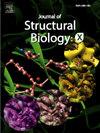The J-shape of β2GPI reveals a cryptic discontinuous epitope across domains I and II
IF 5.1
Q2 BIOCHEMISTRY & MOLECULAR BIOLOGY
引用次数: 0
Abstract
Beta-2-Glycoprotein I is the main target for pathogenic antiphospholipid syndrome autoantibodies. It can adopt several conformations, including an O-shape and two more linear J- and S-shapes. The in vivo existence of the O-shape is debated, and doubt remains pertaining to the pathogenic impact of each shape. Studies have shown that APS antibodies react weakly with the O-shape and bind to the linear shapes due to the exposure of a cryptic epitope in the 1st domain. How the protein transitions from O-shape to the linear shapes remains unknown. While the main epitope is widely recognised as the R39-R43 peptide, there is evidence pointing to a discontinuous epitope across domains I and II (DI & DII). We used molecular dynamics simulations to examine the potential pathways of conformational shift from the O-shape to the open forms, and the impact of plasmin clipping on these pathways. Through these studies, starting in a theorised O-shape, we identified that peptides R39-R43, T50-N56 and R63-F67 become more exposed and have increased stability in the J- and S-shapes relative to the O-shape. These changes are likely due to a shift in DII of the T106-G109 loop, which twists to form contacts with the DI K33-Y36 loop. The R39-R43 peptide is brought closer to R63-F67 suggesting a more complex DI epitope than previously theorised. These effects were observed in the wild type and plasmin clipped model, with the effect being larger in the latter. These results are in good agreement with the increased antibody binding observed experimentally for the clipped protein. We therefore suggest that we have been able to identify the structural mechanism at the residue level which results in increased antibody binding in the J-Shape, and specifically in the clipped protein.

β2GPI呈j形,在结构域I和II之间有一个隐隐约约的不连续表位
β -2-糖蛋白I是致病性抗磷脂综合征自身抗体的主要靶点。它可以采用多种构象,包括o型和两种更线性的J型和s型。在体内存在的o型是有争议的,怀疑仍然有关致病影响的每一个形状。研究表明,APS抗体与o型反应较弱,并与线性形状结合,这是由于暴露了第1结构域的隐性表位。蛋白质是如何从o型转变为线性形状的,目前尚不清楚。虽然主要的表位被广泛认为是R39-R43肽,但有证据表明,在结构域I和II之间存在不连续的表位(DI &; DII)。我们使用分子动力学模拟来研究从o型到开放型构象转变的潜在途径,以及纤溶酶剪切对这些途径的影响。通过这些研究,从理论上的o形开始,我们发现肽R39-R43, T50-N56和R63-F67相对于o形变得更加暴露,并且在J形和s形中具有更高的稳定性。这些变化很可能是由于T106-G109环的DII发生了变化,它与DI K33-Y36环形成了接触。R39-R43肽更接近R63-F67,这表明其DI表位比先前的理论更复杂。这些影响在野生型和纤溶酶剪切模型中均有观察到,后者的影响更大。这些结果与实验中观察到的剪切蛋白的抗体结合增加很好地一致。因此,我们认为我们已经能够在残基水平上确定导致j形抗体结合增加的结构机制,特别是在剪切蛋白中。
本文章由计算机程序翻译,如有差异,请以英文原文为准。
求助全文
约1分钟内获得全文
求助全文
来源期刊

Journal of Structural Biology: X
Biochemistry, Genetics and Molecular Biology-Structural Biology
CiteScore
6.50
自引率
0.00%
发文量
20
审稿时长
62 days
 求助内容:
求助内容: 应助结果提醒方式:
应助结果提醒方式:


